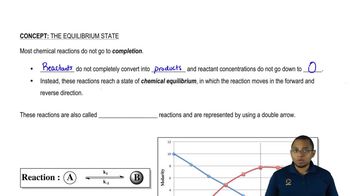State which is greater in amount: reactants or products, based on the given equilibrium constant, K.
a) N2 (g) + O2 (g) ⇌ 2 NO (g) K = 1.0 x 1020
b) 2 CO (g) + O2 (g) ⇌ 2 CO2 (g) K = 2.2 x 10-22
c) 2 BrCl (g) ⇌ Br2 (g) + Cl2 (g) K = 1
 Verified step by step guidance
Verified step by step guidance Verified video answer for a similar problem:
Verified video answer for a similar problem:



 2:50m
2:50mMaster The Equilibrium Constant Concept 1 with a bite sized video explanation from Jules
Start learning